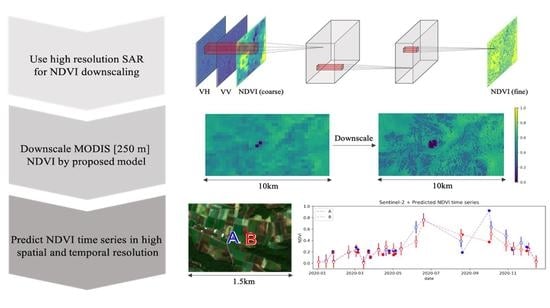Downscaling of MODIS NDVI by Using a Convolutional Neural Network-Based Model with Higher Resolution SAR Data
Abstract
1. Introduction
- A CNN-based NDVI downscaling model using higher spatial resolution SAR data was proposed.
- The model was trained using an up-sampled and original Sentinel-2 image pair with Sentinel-1 image, and was evaluated for different seasons.
- MODIS 250-m NDVI data was input into the trained model and showed advantages for application.
2. Study Area and Data Acquisition
2.1. Study Areas
2.2. Data Acquisition
2.2.1. Sentinel Data
2.2.2. MODIS Data
3. Method
3.1. The CNN-Based Downscaling Model
- Input
- -
- VH: Sentinel-1, 10-m resolution
- -
- VV: Sentinel-1, 10-m resolution
- -
- NDVI: Sentinel-2 or MODIS (differs by experiment), 250-m resolution
- Output
- -
- NDVI Sentinel-2, 10 m
3.2. Concept of the Proposed Model
3.3. Training Settings
4. Results
4.1. Model training with Sentinel-1 and Sentinel-2
4.1.1. Experimental Design
4.1.2. Results
4.2. Prediction with MODIS Data
4.2.1. Data Information
- -
- Search MODIS data within 3 days from the date of the Sentinel-2 data.
- -
- If cloudless data are not found within 3 days, no data are used
- -
- If any cloudless data is found from either Terra and Aqua, acquire all data for ensembling. (see Section 4.2.3 for a detailed explanation)
4.2.2. Experimental Design
4.2.3. Difference between Sentinel-2 and MODIS NDVI
- -
- Collect Terra and Aqua data within 3 days from Sentinel-2 data (see Section 4.2.1)
- -
- For all of the collected data, adopt the median value for each pixel as the ensembled value
4.2.4. Results
4.3. Example of an Application in Tsumagoi
4.3.1. Experimental Design
4.3.2. Results
5. Discussion
5.1. Pros and Cons
5.2. Effective Condition for Application
6. Conclusions
Author Contributions
Funding
Conflicts of Interest
References
- Grafton, R.Q.; Daugbjerg, C.; Qureshi, M.E. Towards food security by 2050. Food Secur. 2015, 7, 179–183. [Google Scholar] [CrossRef]
- Farooq, M.S.; Riaz, S.; Abid, A.; Umer, T.; Bin Zikria, Y. Role of IoT Technology in Agriculture: A Systematic Literature Review. Electronics 2020, 9, 319. [Google Scholar] [CrossRef]
- Tsouros, D.C.; Bibi, S.; Sarigiannidis, P.G. A review on UAV-based applications for precision agriculture. Information 2019, 10, 349. [Google Scholar] [CrossRef]
- Usha, K.; Singh, B. Potential applications of remote sensing in horticulture—A review. Sci. Hortic. 2013, 153, 71–83. [Google Scholar] [CrossRef]
- Yang, C.; Everitt, J.H.; Murden, D. Evaluating high resolution SPOT 5 satellite imagery for crop identification. Comput. Electron. Agric. 2011, 75, 347–354. [Google Scholar] [CrossRef]
- Dong, J.; Xiao, X.; Kou, W.; Qin, Y.; Zhang, G.; Li, L.; Jin, C.; Zhou, Y.; Wang, J.; Biradar, C.; et al. Tracking the dynamics of paddy rice planting area in 1986–2010 through time series Landsat images and phenology-based algorithms. Remote Sens. Environ. 2015, 160, 99–113. [Google Scholar] [CrossRef]
- Inglada, J.; Arias, M.; Tardy, B.; Hagolle, O.; Valero, S.; Morin, D.; Dedieu, G.; Sepulcre, G.; Bontemps, S.; Defourny, P.; et al. Assessment of an Operational System for Crop Type Map Production Using High Temporal and Spatial Resolution Satellite Optical Imagery. Remote Sens. 2015, 7, 12356–12379. [Google Scholar] [CrossRef]
- Zhang, C.; Li, W.; Travis, D. Gaps-fill of SLC-off Landsat ETM+ satellite image using a geostatistical approach. Int. J. Remote Sens. 2007, 28, 5103–5122. [Google Scholar] [CrossRef]
- Zeng, C.; Shen, H.; Zhang, L. Recovering missing pixels for Landsat ETM+ SLC-off imagery using multi-temporal regression analysis and a regularization method. Remote Sens. Environ. 2013, 131, 182–194. [Google Scholar] [CrossRef]
- Zhang, X.; Qin, F.; Qin, Y. Study on the Thick Cloud Removal Method Based on Multi-Temporal Remote Sensing Images. In Proceedings of the 2010 International Conference on Multimedia Technology, Ningbo, China, 2–4 October 2010; pp. 1–3. [Google Scholar]
- Julien, Y.; Sobrino, J.A. Comparison of cloud-reconstruction methods for time series of composite NDVI data. Remote Sens. Environ. 2010, 114, 618–625. [Google Scholar] [CrossRef]
- Lu, X.; Liu, R.; Liu, J.; Liang, S. Removal of Noise by Wavelet Method to Generate High Quality Temporal Data of Terrestrial MODIS Products. Photogramm. Eng. Remote Sens. 2007, 73, 1129–1139. [Google Scholar] [CrossRef]
- Waske, B.; Braun, M. Classifier ensembles for land cover mapping using multitemporal SAR imagery. ISPRS J. Photogramm. Remote Sens. 2009, 64, 450–457. [Google Scholar] [CrossRef]
- Chapman, B.; McDonald, K.; Shimada, M.; Rosenqvist, A.; Schroeder, R.; Hess, L. Mapping Regional Inundation with Spaceborne L-Band SAR. Remote Sens. 2015, 7, 5440–5470. [Google Scholar] [CrossRef]
- Kurosu, T.; Fujita, M.; Chiba, K. Monitoring of rice crop growth from space using the ERS-1 C-band SAR. IEEE Trans. Geosci. Remote Sens. 1995, 33, 1092–1096. [Google Scholar] [CrossRef]
- Bazzi, H.; Baghdadi, N.; El Hajj, M.; Zribi, M.; Minh, D.H.T.; Ndikumana, E.; Courault, D.; Belhouchette, H. Mapping Paddy Rice Using Sentinel-1 SAR Time Series in Camargue, France. Remote Sens. 2019, 11, 887. [Google Scholar] [CrossRef]
- Zhao, W.; Qu, Y.; Chen, J.; Yuan, Z. Deeply synergistic optical and SAR time series for crop dynamic monitoring. Remote Sens. Environ. 2020, 247, 111952. [Google Scholar] [CrossRef]
- Scarpa, G.; Gargiulo, M.; Mazza, A.; Gaetano, R. A CNN-Based Fusion Method for Feature Extraction from Sentinel Data. Remote Sens. 2018, 10, 236. [Google Scholar] [CrossRef]
- Anwar, S.; Khan, S.; Barnes, N. A Deep Journey into Super-resolution: A survey. arXiv 2020, arXiv:1904.07523. [Google Scholar] [CrossRef]
- Lin, C.-H.; Bioucas-Dias, J.M. An Explicit and Scene-Adapted Definition of Convex Self-Similarity Prior With Application to Unsupervised Sentinel-2 Super-Resolution. IEEE Trans. Geosci. Remote Sens. 2020, 58, 3352–3365. [Google Scholar] [CrossRef]
- Lanaras, C.; Bioucas-Dias, J.; Galliani, S.; Baltsavias, E.; Schindler, K. Super-resolution of Sentinel-2 images: Learning a globally applicable deep neural network. ISPRS J. Photogramm. Remote Sens. 2018, 146, 305–319. [Google Scholar] [CrossRef]
- Yokoya, N. Texture-Guided Multisensor Superresolution for Remotely Sensed Images. Remote Sens. 2017, 9, 316. [Google Scholar] [CrossRef]
- Gao, F.; Masek, J.; Schwaller, M.; Hall, F. On the blending of the Landsat and MODIS surface reflectance: Predicting daily Landsat surface reflectance. IEEE Trans. Geosci. Remote Sens. 2006, 44, 2207–2218. [Google Scholar] [CrossRef]
- Li, J.; Wang, S.; Gunn, G.; Joosse, P.; Russell, H.A. A model for downscaling SMOS soil moisture using Sentinel-1 SAR data. Int. J. Appl. Earth Obs. Geoinform. 2018, 72, 109–121. [Google Scholar] [CrossRef]
- Amazirh, A.; Merlin, O.; Er-Raki, S. Including Sentinel-1 radar data to improve the disaggregation of MODIS land surface temperature data. ISPRS J. Photogramm. Remote Sens. 2019, 150, 11–26. [Google Scholar] [CrossRef]
- Bai, J.; Cui, Q.; Zhang, W.; Meng, L. An Approach for Downscaling SMAP Soil Moisture by Combining Sentinel-1 SAR and MODIS Data. Remote Sens. 2019, 11, 2736. [Google Scholar] [CrossRef]
- Mazza, A.; Gargiulo, M.; Scarpa, G.; Gaetano, R. Estimating the NDVI from SAR by Convolutional Neural Networks. In Proceedings of the IGARSS 2018—2018 IEEE International Geoscience and Remote Sensing Symposium, Valencia, Spain, 23–27 July 2018; pp. 1954–1957. [Google Scholar]
- Veloso, A.; Mermoz, S.; Bouvet, A.; Le Toan, T.; Planells, M.; Dejoux, J.-F.; Ceschia, E. Understanding the temporal behavior of crops using Sentinel-1 and Sentinel-2-like data for agricultural applications. Remote Sens. Environ. 2017, 199, 415–426. [Google Scholar] [CrossRef]
- Bousbih, S.; Zribi, M.; Lili-Chabaane, Z.; Baghdadi, N.; El Hajj, M.; Gao, Q.; Mougenot, B. Potential of Sentinel-1 Radar Data for the Assessment of Soil and Cereal Cover Parameters. Sensors 2017, 17, 2617. [Google Scholar] [CrossRef] [PubMed]
- Mattia, F.; Le Toan, T.; Picard, G.; Posa, F.I.; D’Alessio, A.; Notarnicola, C.; Gatti, A.M.; Rinaldi, M.; Satalino, G.; Pasquariello, G. Multitemporal c-band radar measurements on wheat fields. IEEE Trans. Geosci. Remote Sens. 2003, 41, 1551–1560. [Google Scholar] [CrossRef]
- Benedetti, R.; Rossini, P. On the use of NDVI profiles as a tool for agricultural statistics: The case study of wheat yield estimate and forecast in Emilia Romagna. Remote Sens. Environ. 1993, 45, 311–326. [Google Scholar] [CrossRef]
- Lunetta, R.S.; Knight, J.F.; Ediriwickrema, J.; Lyon, J.G.; Worthy, L.D. Land-cover change detection using multi-temporal MODIS NDVI data. Remote Sens. Environ. 2006, 105, 142–154. [Google Scholar] [CrossRef]
- Yang, L.; Wylie, B.K.; Tieszen, L.L.; Reed, B.C. An Analysis of Relationships among Climate Forcing and Time-Integrated NDVI of Grasslands over the U.S. Northern and Central Great Plains. Remote Sens. Environ. 1998, 65, 25–37. [Google Scholar] [CrossRef]
- ESA. Copernicus Sentinel Data 2019~2020, Processed by ESA. Available online: https://scihub.copernicus.eu/ (accessed on 24 December 2020).
- Lee, J.-S.; Wen, J.-H.; Ainsworth, T.L.; Chen, K.-S.; Chen, A.J. Improved Sigma Filter for Speckle Filtering of SAR Imagery. IEEE Trans. Geosci. Remote Sens. 2009, 47, 202–213. [Google Scholar] [CrossRef]
- ESA. SNAP (Sentinel Application Platform) Software. Available online: https://step.esa.int/main/toolboxes/snap/ (accessed on 6 December 2020).
- Vermote, E.F.; El Saleous, N.Z.; O Justice, C. Atmospheric correction of MODIS data in the visible to middle infrared: First results. Remote Sens. Environ. 2002, 83, 97–111. [Google Scholar] [CrossRef]
- Krizhevsky, A.; Sutskever, I.; Hinton, G.E. Imagenet classification with deep convolutional neural networks. Commun. ACM 2017, 60, 84–90. [Google Scholar] [CrossRef]
- He, K.; Gkioxari, G.; Dollár, P.; Girshick, R. Mask R-CNN. arXiv 2018, arXiv:1703.06870. [Google Scholar]
- Zhu, J.-Y.; Park, T.; Isola, P.; Efros, A.A. Unpaired Image-to-Image Translation Using Cycle-Consistent Adversarial Networks. arXiv 2020, arXiv:1703.10593. [Google Scholar]
- Dong, C.; Loy, C.C.; He, K.; Tang, X. Image Super-Resolution Using Deep Convolutional Networks. IEEE Trans. Pattern Anal. Mach. Intell. 2015, 38, 295–307. [Google Scholar] [CrossRef] [PubMed]
- Wu, S.-T.; Sader, S. Multipolarization SAR Data for Surface Feature Delineation and Forest Vegetation Characterization. IEEE Trans. Geosci. Remote Sens. 1987, 25, 67–76. [Google Scholar] [CrossRef]
- Kingma, D.P.; Ba, J. Adam: A method for stochastic optimization. arXiv 2017, arXiv:1412.6980. [Google Scholar]
- Ryu, J.-H.; Na, S.-I.; Cho, J. Inter-Comparison of Normalized Difference Vegetation Index Measured from Different Footprint Sizes in Cropland. Remote Sens. 2020, 12, 2980. [Google Scholar] [CrossRef]
- Lange, M.; DeChant, B.; Rebmann, C.; Vohland, M.; Cuntz, M.; Doktor, D. Validating MODIS and Sentinel-2 NDVI Products at a Temperate Deciduous Forest Site Using Two Independent Ground-Based Sensors. Sensors 2017, 17, 1855. [Google Scholar] [CrossRef] [PubMed]
- Oki, K.; Mitsuishi, S.; Ito, T.; Mizoguchi, M. An Agricultural Monitoring System Based on the Use of Remotely Sensed Imagery and Field Server Web Camera Data. GISci. Remote Sens. 2009, 46, 305–314. [Google Scholar] [CrossRef]
- Oki, K.; Mizoguchi, M.; Noborio, K.; Yoshida, K.; Osawa, K.; Mitsuishi, S.; Ito, T. Accuracy comparison of cabbage coverage estimated from remotely sensed imagery using an unmixing method. Comput. Electron. Agric. 2011, 79, 30–35. [Google Scholar] [CrossRef]
- Reyes, M.F.; Auer, S.; Merkle, N.; Henry, C.; Schmitt, M. SAR-to-Optical Image Translation Based on Conditional Generative Adversarial Networks—Optimization, Opportunities and Limits. Remote Sens. 2019, 11, 2067. [Google Scholar] [CrossRef]
- Wang, L.; Xu, X.; Yu, Y.; Yang, R.; Gui, R.; Xu, Z.; Pu, F. SAR-to-Optical Image Translation Using Supervised Cycle-Consistent Adversarial Networks. IEEE Access 2019, 7, 129136–129149. [Google Scholar] [CrossRef]
- Perez, L.; Wang, J. The Effectiveness of Data Augmentation in Image Classification using Deep Learning. arXiv 2017, arXiv:1712.04621. [Google Scholar]
- Wang, Y.; Wang, C.; Zhang, H. Ship Classification in High-Resolution SAR Images Using Deep Learning of Small Datasets. Sensors 2018, 18, 2929. [Google Scholar] [CrossRef]
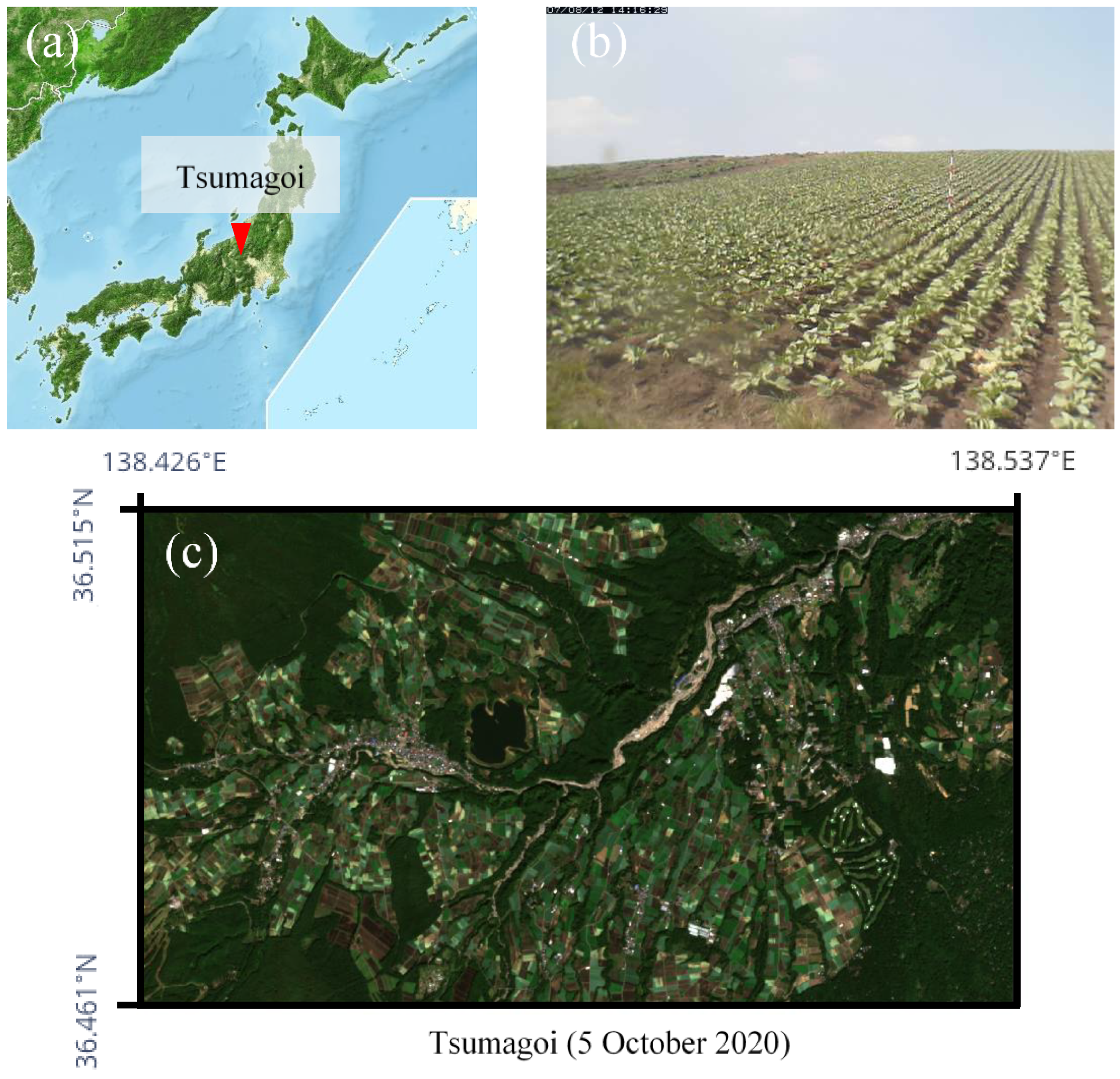
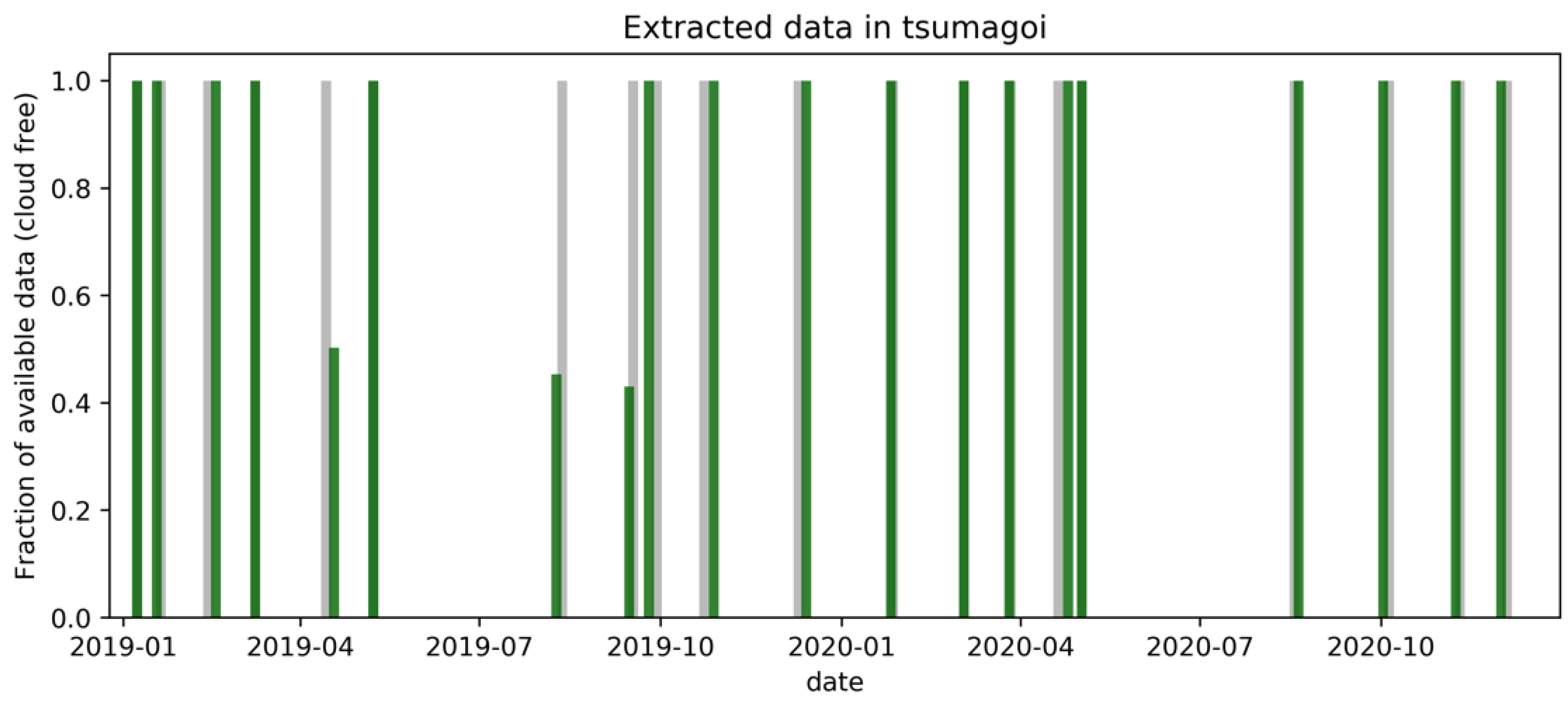


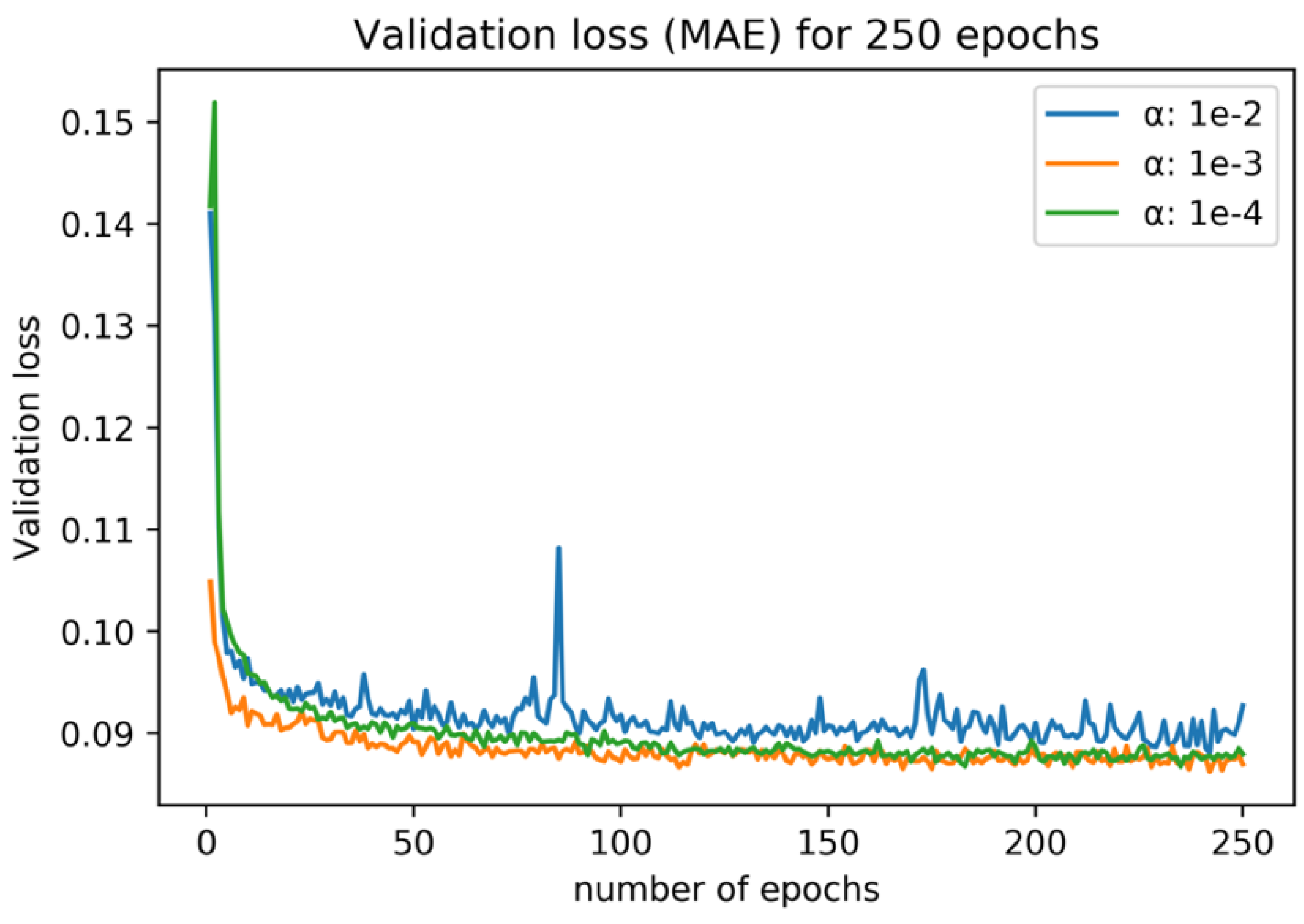
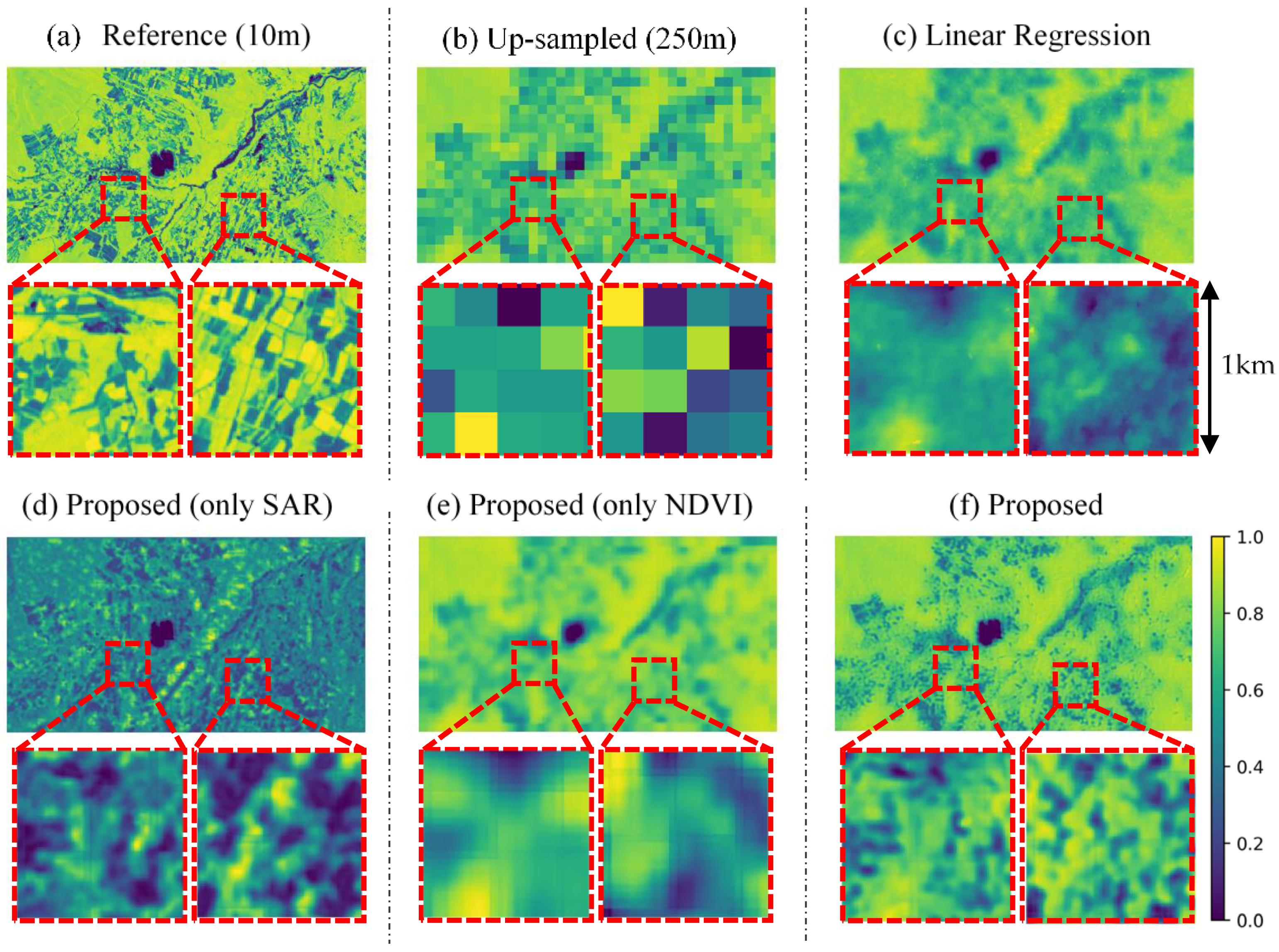
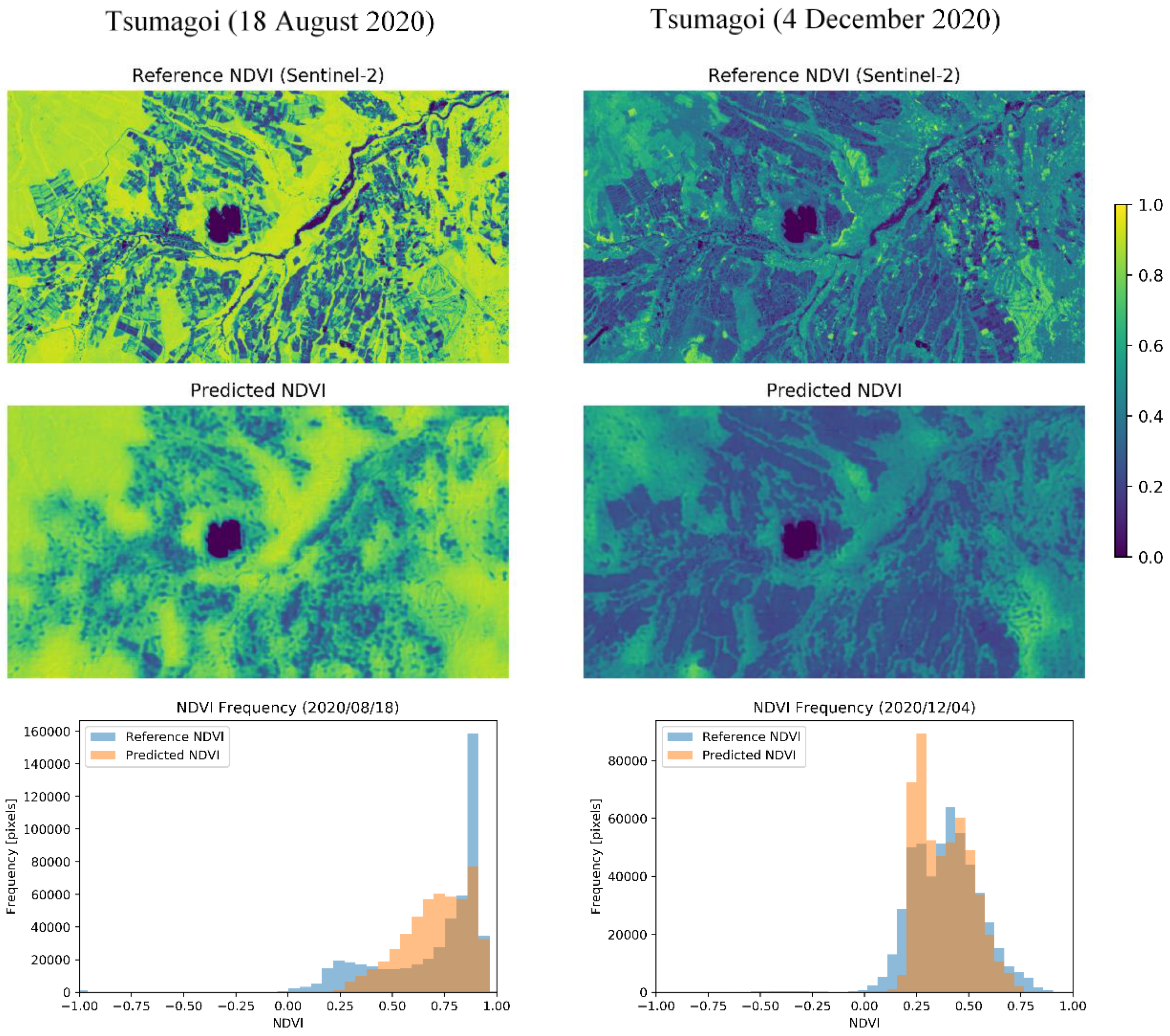
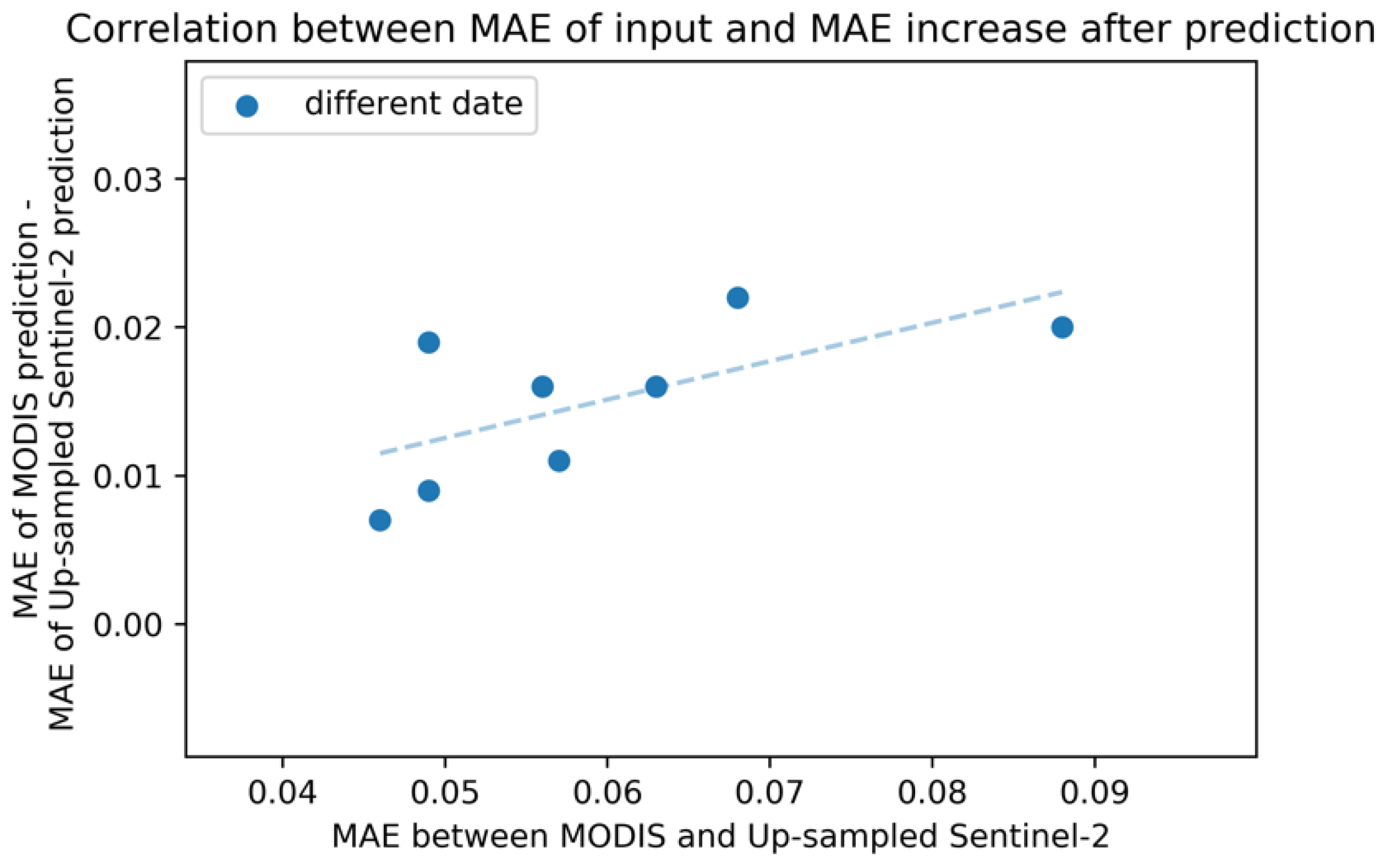
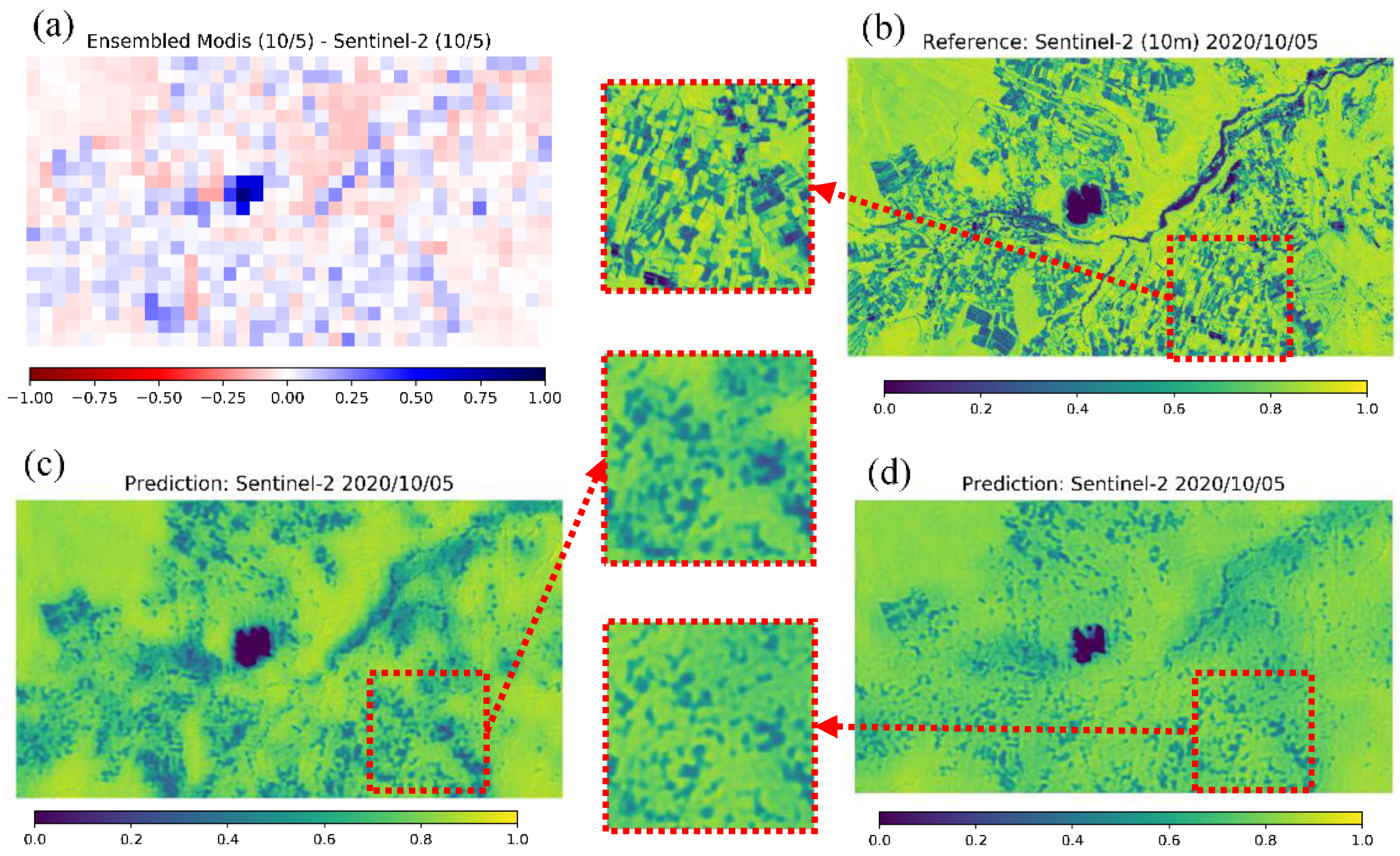
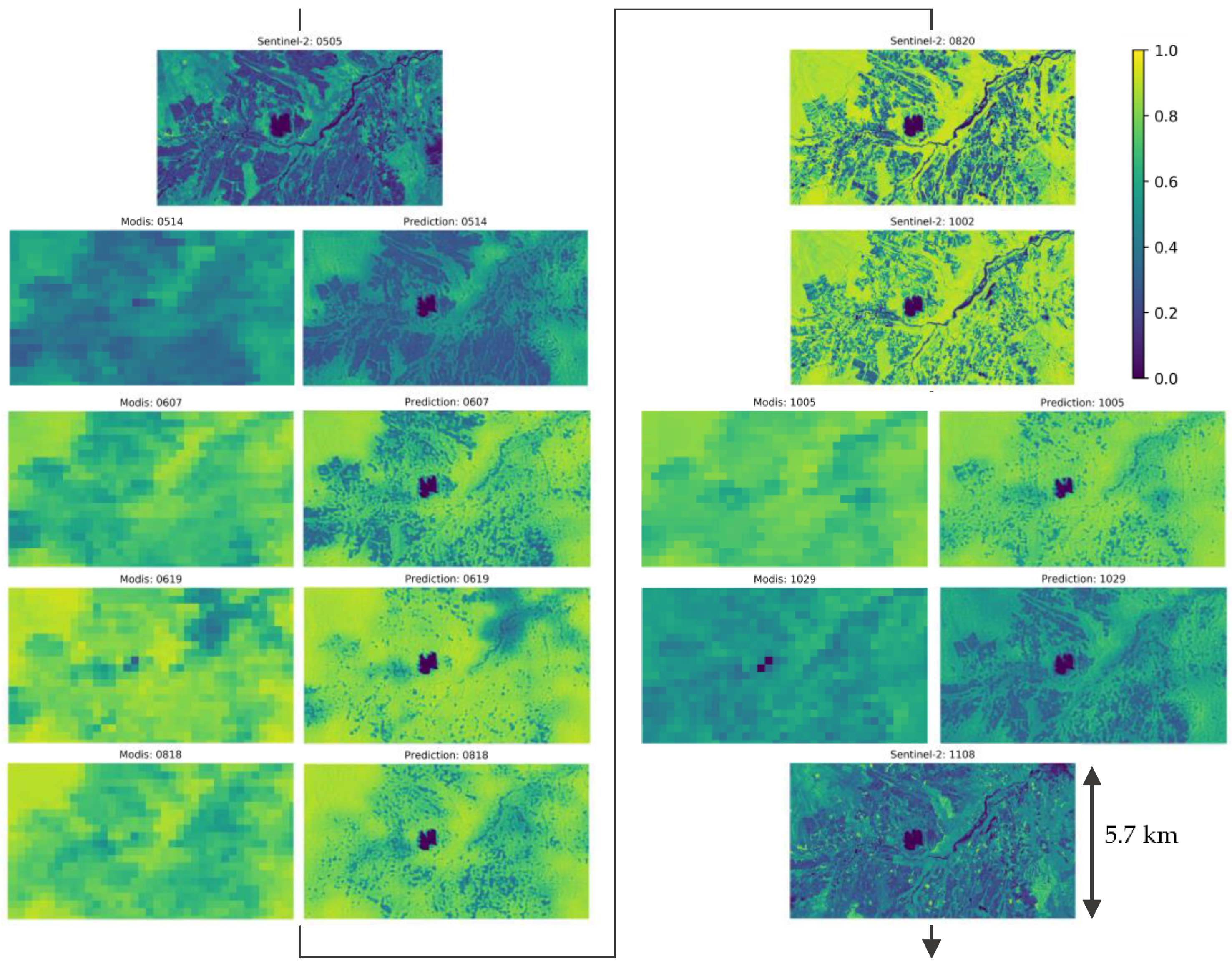
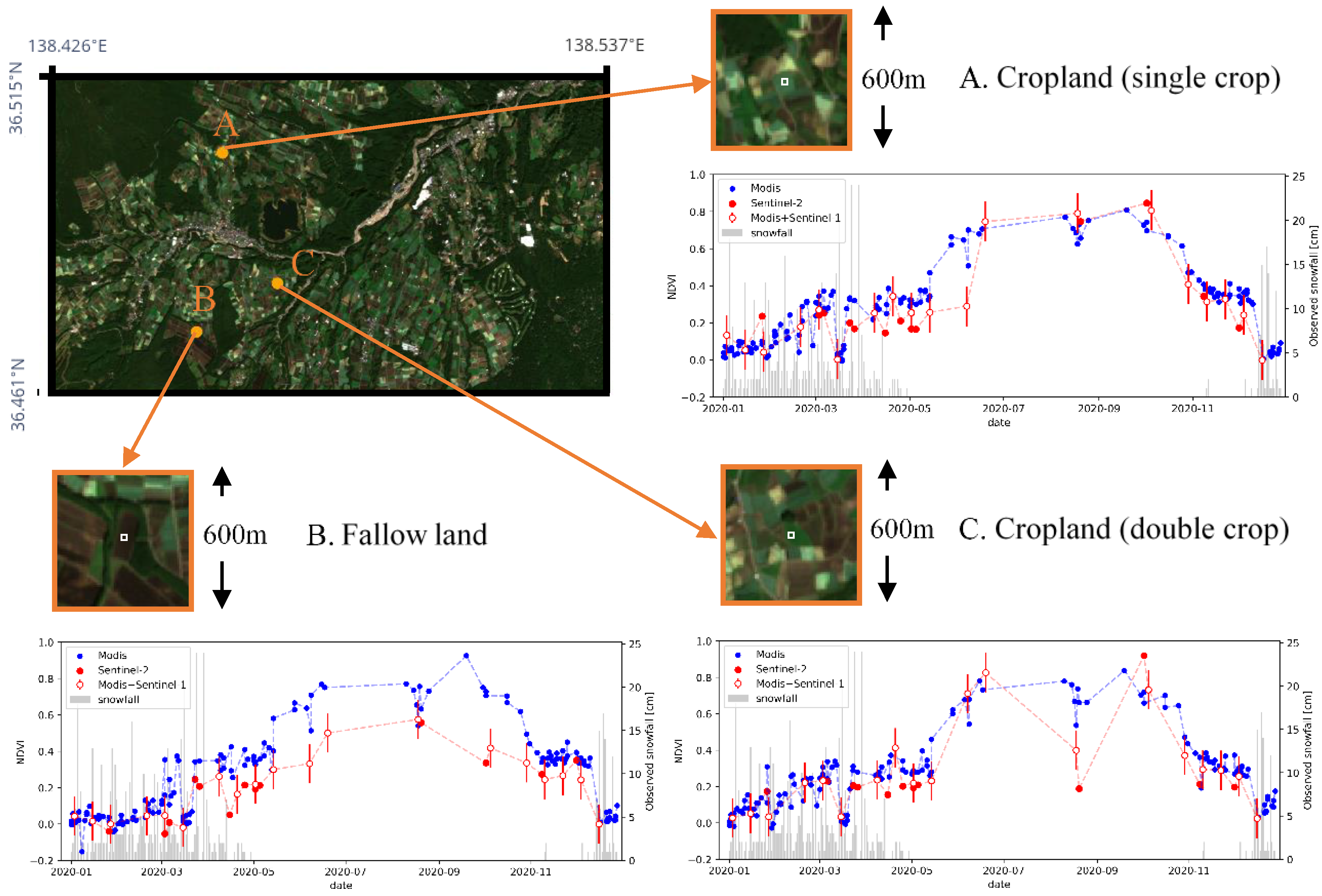
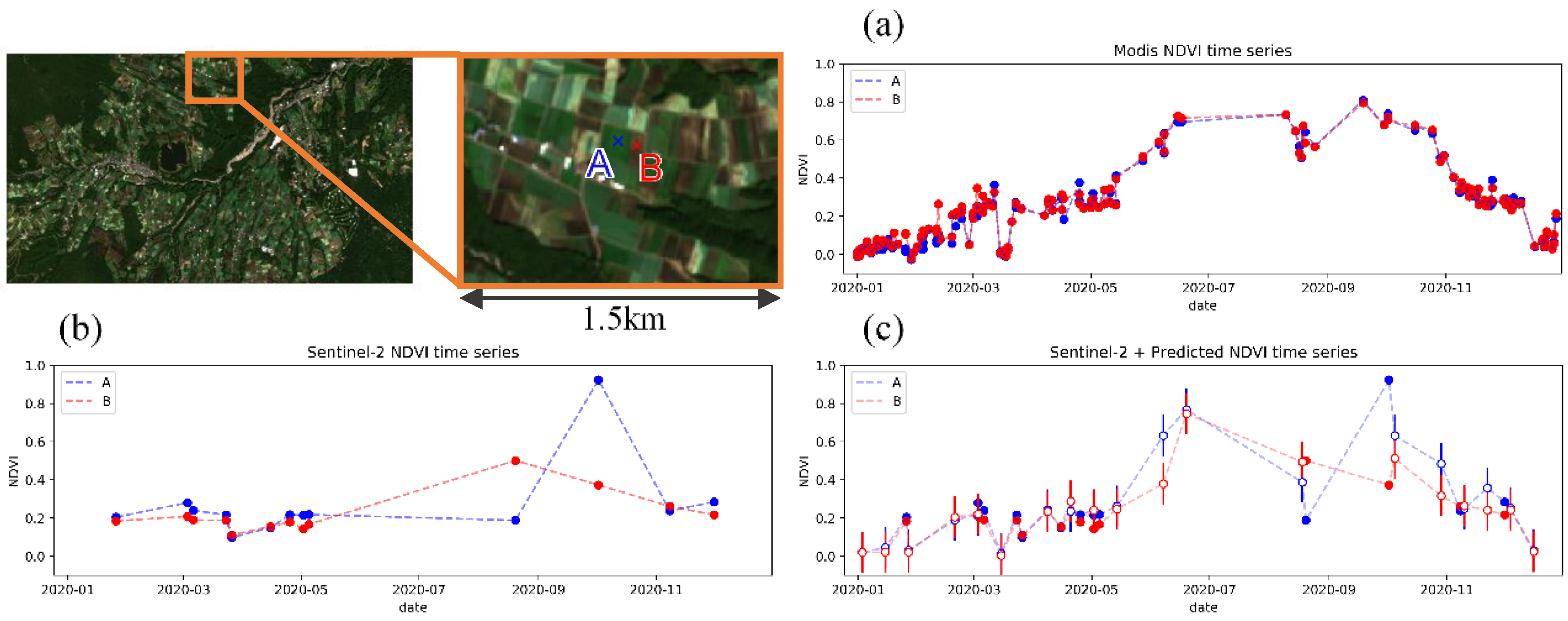
| ConvLayer 1 | Activation | ConvLayer 2 | Activation | ConvLayer 3 | |
|---|---|---|---|---|---|
| Filter number | 64 | ReLU | 32 | ReLU | 1 |
| Kernel size | 9 | 1 | 5 | ||
| Shape of y(i) | 64 × (125 × 125) | 32 × (125 × 125) | 1 × (125 × 125) |
| Date | 0127 | 0303 | 0327 | 0420 | 0502 | 0818 | 1005 | 1110 | 1204 | Mean | |
|---|---|---|---|---|---|---|---|---|---|---|---|
| Interval days | 7 | 6 | 18 | 18 (6) | 4 | 42 (6) | 18 | 18 | 6 | - | |
| Linear-Regression | MAE | 0.101 | 0.094 | 0.073 | 0.074 | 0.077 | 0.143 | 0.116 | 0.088 | 0.087 | 0.095 |
| ρ | 0.629 | 0.724 | 0.700 | 0.713 | 0.741 | 0.705 | 0.640 | 0.666 | 0.720 | 0.693 | |
| Proposed-CNN | MAE | 0.100 | 0.088 | 0.071 | 0.074 | 0.072 | 0.131 | 0.105 | 0.088 | 0.084 | 0.090 |
| ρ | 0.661 | 0.786 | 0.726 | 0.724 | 0.785 | 0.773 | 0.700 | 0.692 | 0.759 | 0.734 | |
| Tsumagoi | |||
|---|---|---|---|
| Sentinel-1 | Sentinel-2 | MODIS-Terra | MODIS-Aqua |
| 27 January | 26 January | 26 January | 26 January, 29 January |
| 3 March | 3 March | 1 March, 6 March | 1 March, 3 March, 6 March |
| 27 March | 26 March | - | - |
| 20 April | 25 April | 25 April | 25 April, 27 April |
| 2 May | 2 May | 1 May, 2 May, 5 May | 1 May, 2 May |
| 18 August | 20 August | 18 August~20 August | - |
| 5 October | 2 October | 30 September, 2 October | 2 October |
| 10 November | 8 November | 8 November, 10 November | 9 November |
| 4 December | 1 December | 1 December | 1 December~4 December |
| Terra | Aqua | Ensemble | |
|---|---|---|---|
| MAE | 0.066 | 0.061 | 0.060 |
| ρ | 0.706 | 0.703 | 0.730 |
| Tsumagoi | 0127 | 0303 | 0420 | 0502 | 0818 | 1005 | 1110 | 1204 | Mean | |
|---|---|---|---|---|---|---|---|---|---|---|
| Sentinel-2 input | MAE | 0.100 | 0.088 | 0.074 | 0.072 | 0.131 | 0.105 | 0.088 | 0.084 | 0.093 |
| ρ | 0.661 | 0.786 | 0.724 | 0.785 | 0.773 | 0.700 | 0.692 | 0.759 | 0.735 | |
| MODIS input | MAE | 0.122 | 0.104 | 0.093 | 0.083 | 0.151 | 0.121 | 0.095 | 0.093 | 0.108 |
| ρ | 0.510 | 0.670 | 0.618 | 0.738 | 0.731 | 0.621 | 0.608 | 0.706 | 0.650 | |
| Sentinel-1 | MODIS-Terra | MODIS-Aqua | Sentinel-2 |
|---|---|---|---|
| 3 January | 1 January, 2 January, 4 January, 6 January | 1 January, 2 January, 4 January, 6 January | - |
| 15 January | 13 January, 14 January, 16 January | 17 January | - |
| - | - | - | 26 January |
| 27 January | 26 January, 30 January | 29 January | - |
| 20 February | 19 February, 21 February | 19 February, 21 February | - |
| 3 March | 1 March, 3 March, 6 March | 1 March, 3 March, 6 March | - |
| - | - | - | 3 March |
| - | - | - | 6 March |
| 15 March | 12 March, 15 March, 17 March, 18 March | 15 March, 17 March, 18 March | - |
| - | - | - | 23 March |
| - | - | - | 26 March |
| 8 April | 9 April, 11 April | 9 April, 11 April | - |
| - | - | - | 15 April |
| - | - | - | 25 April |
| 2 May | 1 May, 2 May | 1 May, 2 May | - |
| - | - | - | 2 May |
| - | - | - | 5 May |
| 14 May | 11 May, 14 May | 11 May, 13 May, 14 May | - |
| 7 June | 5 June, 8 June | 5 June, 8 June | - |
| 19 June | 17 June | 20 June | - |
| 18 August | 15 August, 16 August, 18 August~20 August | 17 August | - |
| - | - | - | 20 August |
| - | - | - | 2 October |
| 5 October | 2 October | 2 October | - |
| 29 October | - | 29 October, 31 October | - |
| - | - | - | 8 November |
| 10 November | 8 November, 10 November, 12 November, 13 November | 9 November, 12 November | - |
| 22 November | 22 November, 24 November, 25 November | 21 November, 23 November, 25 November | - |
| - | - | - | 1 December |
| 4 December | 1 December | 1 December~7 November | - |
| 16 December | 17 December | - | - |
Publisher’s Note: MDPI stays neutral with regard to jurisdictional claims in published maps and institutional affiliations. |
© 2021 by the authors. Licensee MDPI, Basel, Switzerland. This article is an open access article distributed under the terms and conditions of the Creative Commons Attribution (CC BY) license (http://creativecommons.org/licenses/by/4.0/).
Share and Cite
Nomura, R.; Oki, K. Downscaling of MODIS NDVI by Using a Convolutional Neural Network-Based Model with Higher Resolution SAR Data. Remote Sens. 2021, 13, 732. https://doi.org/10.3390/rs13040732
Nomura R, Oki K. Downscaling of MODIS NDVI by Using a Convolutional Neural Network-Based Model with Higher Resolution SAR Data. Remote Sensing. 2021; 13(4):732. https://doi.org/10.3390/rs13040732
Chicago/Turabian StyleNomura, Ryota, and Kazuo Oki. 2021. "Downscaling of MODIS NDVI by Using a Convolutional Neural Network-Based Model with Higher Resolution SAR Data" Remote Sensing 13, no. 4: 732. https://doi.org/10.3390/rs13040732
APA StyleNomura, R., & Oki, K. (2021). Downscaling of MODIS NDVI by Using a Convolutional Neural Network-Based Model with Higher Resolution SAR Data. Remote Sensing, 13(4), 732. https://doi.org/10.3390/rs13040732




